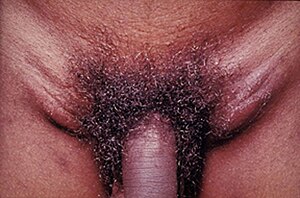Lymphogranuloma venereum
From WikiLectures
Lymphogranuloma venereum is a sexually transmitted disease manifested by an ulcer. It occurs mainly in the tropics and subtropics (Asia, Africa, South America).
Etiology[edit | edit source]
Lymphogranuloma venereum is caused by Chlamydia trachomatis, which penetrates the damaged mucosa.
Clinical manifestation[edit | edit source]
The incubation period lasts approximately 14 days but can range from 2 to 30 days.
- stage - a small ulcer on the mucous membrane is formed, which is often overlooked.
- stage - swelling of the descending nodes, they gradually merge, coiling and forming fistulas. The discharge is purulent and during healing, scars form. General symptoms accompanied by a non-specific rash may be present.
- stage – arises as a consequence of a disorder of the lymphatic system - anogenital lymphedema (so-called esthiomene)
Serology is used - a complement fixation reaction with a high titer of antibodies.
Differential diagnosis[edit | edit source]
It is necessary to distinguish other genital ulcers. A hard, painless ulcer is a symptom of syphilis, a soft ulcer of the chancroid. It is also necessary to distinguish Herpes simplex, etc.
Therapy[edit | edit source]
Doxycycline 200 mg/day and erythromycin 2 g/day are given p.o. for 21 days.
Course and prognosis[edit | edit source]
It is good after treatment.
Links[edit | edit source]
Related articles[edit | edit source]
Sources[edit | edit source]
- ŠTORK, Jiří, et al. Dermatovenerologie. 1. vydání. Praha : Galén, Karolinum, 2008. 502 s. ISBN 978-80-7262-371-6.

